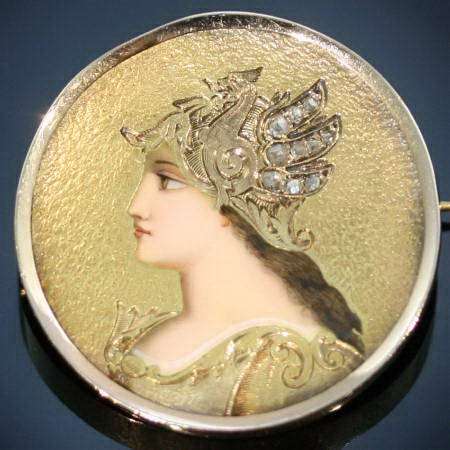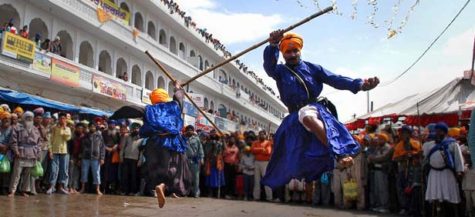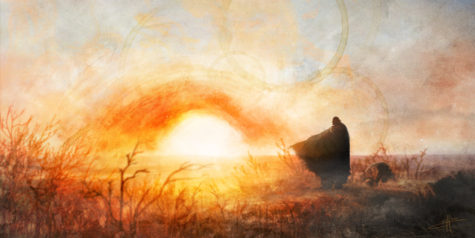Poetry Reading
Thorrablot (Þorrablót) was a sacrificial midwinter festival offered to the gods in pagan Iceland of the past. It was abolished during the Christianization of Iceland, but resurrected in the 19th century as a midwinter celebration that continues to be celebrated to this day. The timing for the festival coincides with the month of Thorri, according to the old Icelandic calendar, which begins on the first Friday after January 19th (the 13th week of winter). Or, on the 19th when it falls on a Friday.
Origins of the name “Thorri” are unclear but it is most likely derived from Norwegian king Thorri Snærsson, or Thor the God of Thunder in the old Nordic religion.
Today Thorrablot are common events among Icelanders everywhere and can be anything from an informal dinner with friends and family to large organised events with stage performances and an after-dinner dance. These large Thorrablot celebrations are usually arranged by membership associations, associations of Icelanders living abroad, and as regional festivals in the countryside.
On this occasion, locals come together to eat, drink and be merry. Customary, the menu consists of unusual culinary delicacies, known as traditional Icelandic food, which consist of different versions of animal parts, either fermented in lactic acid, rotten, salted or soured. These include rotten shark’s meat (hákarl), boiled sheep’s head, (svið) and congealed sheep’s blood wrapped in a ram’s stomach (blóðmör)! This is traditionally washed down with some Brennivin – also known as Black Death – a potent schnapps made from potato and caraway.
Even though most Icelanders do indulge in the traditional foods at least once a year, not many foreigners, nor the younger generation of Icelanders like the food.
After the Thorrablot dinner traditional songs, games and story telling are accompanied by dancing and in true Icelandic style continue until the early hours of the morning! If you fail to receive a personal invitation to a family feast, local restaurants will often add Thorrablot color and taste to their menus.
According to many pagan calendars, May 8th is listed as “The Festival of Mens , the Roman goddess of mind and consciousness.” I did not, however, find any information on Mens or on a festival of Mens – what I did find was this small excerpt at Wikipedia:
By a process of folk etymology, the Romans could have confused the phones of her foreign name with those of the root men- in Latin words such as mens meaning “mind”, perhaps because one of her aspects as goddess pertained to the intellectual. The word mens is built from the Proto-Indo-European root *men- ‘mind’ (linked with memory as in Greek Mnemosyne; memory, remembrance, recollection, Manush in Sanskrit meaning mind ).
Because of this, I can only assume that the Festival of Mens is actually a Festival of Minerva, Goddess of wisdom and learning, meditation, inventiveness, accomplishments, the arts, spinning and weaving, and commerce. Minerva was identified with Pallas Athene, bestower of victory, when Pompey the Great built her temple with the proceeds from his eastern campaigns.
The Romans celebrated her festival from March 19 to March 23 during the day which is called, in the neuter plural, Quinquatria, the fifth after the Ides of March, the nineteenth, an artisans’ holiday. A lesser version, the Minusculae Quinquatria, was held on the Ides of June, June 13, by the flute-players, who were particularly useful to religion.
Source: Wikipedia
Hola Mohalla is an annual Sikh festival, celebrated extensively over three days (March 13 thru 15) mainly at the Anandpur Sahib Gurudwara, in the state of Punjab. It is a martial fair that was introduced by Sikh Guru, Guru Gobind Singh, to fortify the Sikh community by carrying out martial training and mock-drills, along with religious discussions.
The festivities of Hola Mohalla begin by visiting the gurudwaras for early morning prayers. Durbars are held and the Guru Granth Sahib is read. Kirtans and religious lectures are carried out and after the religious ceremonies are over, the ‘prasad’ is distributed among the people.
The evening is filled with a lot of anticipation and thrill, as martial members of the Sikh community (Nihang Sikhs) display their physical strength through daring acts like mock-battles (Gatka), sword-fighting displays, archery and exercising on speeding horses. They also splatter colors on the audience.
This is followed by cultural activities including music, dance and poetry programs and competitions to unwind the charged up atmosphere. A procession is set out on the last day, and the Panj Pyaras walk in front crossing all the major gurudwaras in that area.
Hola Mohalla is the time to celebrate and dedicate oneself into community service. ‘Langars’ are organised, and local people come forward to help by arranging the raw materials for the langar, cleaning the gurudwaras, and washing the dishes.
Here’s a Video:
Source: Journey Mart
Kalevala Day is celebrated in Finland on 28 February, to match Elias Lönnrot’s first version of The Kalevala in 1835. It is an official flag-raising day in Finland, and simultaneously the Day of Finnish culture. The epic poem, Kalevala is celebrated by the Finns with parades and readings from the poem.
- Themes: Creativity; Tradition; Fertility; Beginnings
- Symbols: Egg; East Wind: Poetry
- Presiding Goddess: Luonnotar
About Luonnotar:
A Finno-Ugric creatrix, Luonnotar closes the month of February with an abundance of creative, fertile energy. Her name means “daughter of earth,” and according to legend she nurtured the cosmic eggs from which the sun, moon, and stars developed. In the Kalevala, Luonnotar is metaphorically represented as the refreshing east wind – the wind of beginnings. She also created the first bard, Vainamolen.
To Do Today:
The Kalevala is the epic poem of more than twenty thousand verses that recounts the history and lore of the Finnish people. Luonnotar appears in the creation stanzas, empowering the entire ballad with her energy. If there’s anything in your life that needs an inventive approach or ingenious nudge, stand in an easterly wind today and let Luonnotar’s power restore your personal muse. If the wind doesn’t cooperate, stand instead in the breeze created by a fan facing west.
To generate fertility or internalize a little extra resourcefulness as a coping mechanism in any area of your life, make eggs part of a meal today. Cook them sunny side up for a “sunny” disposition, over easy to motivate easy transitions, or hard boiled to strengthen your backbone!
Another way to celebrate the day would be with a reading from the Kalevala, some of which can be found at Widdershins – just search the tag: Kalevala. There is also a nice Finnish Healing Spell adapted from the Kalevala on Book of Shadows
From: 365 Goddess
 In Greek tradition, the Goddess Mnemosyne gave birth to the Muses today (June 14) – the nine creative spirit children that give our lives so much beauty, song, stories, tradition, humor, dance, and sacred music. For a magickal celebration here is something from A Daily Guide to the Magic and Inspiration of the Goddess.
In Greek tradition, the Goddess Mnemosyne gave birth to the Muses today (June 14) – the nine creative spirit children that give our lives so much beauty, song, stories, tradition, humor, dance, and sacred music. For a magickal celebration here is something from A Daily Guide to the Magic and Inspiration of the Goddess.
- Themes: Creativity; Knowledge; History; Art
- Symbols: Fountains; Springs; the Number Nine
- Presiding Goddess: Mnemosyne
About Mnemosyne:
Greeks sometimes worshiped Mnemosyne in the form of a spring, alluding to her profuse, flowing energy. Mnemosyne means “memory.” Remembrance is this goddess’s gift to us, memories of all the wonderful moments of our lives.
To do today:
Absolutely anything thoughtful, creative, or inspiring will grab Mnemosyne’s attention and encourage her participation in your day. Try donning a unique combination of clothing that really motivates you to do your best, or something that provokes fond memories from the past. Wear an aroma that arouses your inventive nature or cognitive abilities (jasmine and rosemary are two good choices, respectively).
If there are special arts that you’ve learned from family or friends, celebrate them today. Hum that little ditty from your childhood, dust off that neglected craft item, try those recipes, listen to old songs, and let Mnemosyne fill your hours with the encouragement that comes from fond “musings.”
January 25, the birthday of Scotland’s most famous poet, Robert Burns (1759-1796), has become an occasion for Scots all over the world to gather together in his honor. A Burns Night supper usually includes haggis, a traditional dish of the heart, lungs, and liver of a sheep or calf minced with suet, onions, oatmeal, and seasonings. Burns’s words: “Hail Great Chieftan o’ the Puddin-race!” greets the dish’s entry into the room. Men wear kilts and women their tartan sashes, and the evening’s celebration includes reading Burns’s poems and singing his songs, ending with one of his most famous, “Auld Lang Syne.
Found at Almanac.com
 Mawlid (Arabic: مَولِد النَّبِي , “Birth of the Prophet”) is the observance of the birthday of the Islamic prophet Muhammad which is celebrated often on the 12th day of Rabi’ al-awwal, the third month in the Islamic calendar. The 12th Day of Rabi’ al-awwall is the most popular date from a list of many dates that are reported as the birth date.
Mawlid (Arabic: مَولِد النَّبِي , “Birth of the Prophet”) is the observance of the birthday of the Islamic prophet Muhammad which is celebrated often on the 12th day of Rabi’ al-awwal, the third month in the Islamic calendar. The 12th Day of Rabi’ al-awwall is the most popular date from a list of many dates that are reported as the birth date.
In some countries, such as Egypt and Sudan, Mawlid is used as a generic term for the celebration of birthdays of local Sufi saints and not only restricted to the observance of the birth of Muhammad. Around 3,000 Mawlid celebrations are held each year. These festivals attract an international audience, with the largest one in Egypt attracting up to three million people honoring Ahmad al-Badawi, a local 13th-century Sufi saint.
Mawlid is recognized as a national holiday in most of the Muslim-majority countries of the world except Saudi Arabia and Qatar.
Along with being referred to as the celebration of the birth of Muhammad, the term Mawlid also refers to the ‘text especially composed for and recited at Muhammad’s nativity celebration’ or “a text recited or sung on that day”.
The date of Muhammad’s birth is a matter of contention since the exact date is unknown and is not definitively recorded in the Islamic traditions. Among the most recognizable dates, Sunni Muslims believe the date to have been on the twelfth of Rabi’ al-awwal, whereas Shi’a Muslims believe the date to have been on the seventeenth.
Among Muslim scholars, the legality of Mawlid “has been the subject of intense debate” and has been described as “perhaps one of the most polemical discussions in Islamic law”. Traditionally, most Sunni and nearly all of the Shia scholars have approved of the celebration of Mawlid, while Wahhabi and Ahmadiyya scholars oppose the celebration.
Examples of historic Sunni scholars who permitted the Mawlid include the Shafi’i scholar Al-Suyuti (d 911 A.H.) who stated that:
My answer is that the legal status of the observance of the Mawlid – as long as it just consists of a meeting together by the people, a recitation of apposite parts of the Qur’an, the recounting of transmitted accounts of the beginning of (the biography of) the Prophet – may God bless him and grant him peace – and the wonders that took place during his birth, all of which is then followed by a banquet that is served to them and from which they eat – is a good innovation (bid’a hasana), for which one is rewarded because of the esteem shown for the position of the Prophet – may God bless him and grant him peace – that is implicit in it, and because of the expression of joy and happiness on his – may God bless him and grant him peace – noble birth.
The Shafi’i scholar Ibn Hajar al-Asqalani (d 852 A.H.) too approved of the Mawlid and states that:
As for what is performed on the day of the Mawlid, one should limit oneself to what expresses thanks to God, such as the things that have already been mentioned: [Qur’anic] recitation, serving food, alms-giving, and recitation of praise [poems] about the Prophet – may God bless him and grant him peace – and asceticism which motivate people to perform good deeds and act in view of the next world.
Mawlid is celebrated in almost all Islamic countries, and in other countries that have a significant Muslim population, such as India, the United Kingdom, Nepal, Sri Lanka, France, Germany, Italy, Russia and Canada. The only exceptions are Qatar and Saudi Arabia where it is not an official public holiday and is forbidden.
Often organized in some countries by the Sufi orders, Mawlid is celebrated in a carnival manner, large street processions are held and homes or mosques are decorated. Charity and food is distributed, and stories about the life of Muhammad are narrated with recitation of poetry by children. Scholars and poets celebrate by reciting Qaṣīda al-Burda Sharif, the famous poem by 13th-century Arabic Sufi Busiri.
A general Mawlid appears as “a chaotic, incoherent spectacle, where numerous events happen simultaneously,all held together only by the common festive time and space”. These celebrations are often considered an expression of the Sufi concept of the pre-existence of Muhammad . However,the main significance of these festivities is expression of love for Muhammad.
During Pakistan’s Mawlid the day starts with a 31-gun salute in federal capital and a 21-gun salute at the provincial capitals and religious hymns are sung during the day.
In many parts of Indonesia, the celebration of the Mawlid al-nabi “seems to surpass in importance, liveliness, and splendour” the two official Islamic holidays of Eid ul-Fitr and Eid al-Adha.
In Qayrawan, Tunisia, Muslims sing and chant hymns of praise to Muhammad, welcoming him in honor of his birth.Also, generally in Tunisia, people usually prepare Assidat Zgougou to celebrate the Mawlid.
Assidat Zgougou is a Tunisian dessert originally made out of honey, smen and semolina, that dish is now known as “εasida turki”
The lower layer is made of the grains of Aleppo pines “zgougou.” The grains are cleaned, then they are ground in water and sieved to very small sizes. The resulting juicy substance is then mixed with wheat flour and/or starch depending on the recipe. Sometimes concentrated milk is added. Then everything is cooked at low heat while stirred. Powdered sugar is added gradually as the mixture thickens, giving rise to a grayish-brown color.
The result is poured hot in a bowl and cover in a white cream made out of milk, starch, sugar, eggs and a bit of orange blossom essence then decorated with almonds and other seeds and nuts, whole or ground, and small candy.
It is also possible to make an assida out of other nuts instead of the allepo pine’s grains, like hazelnuts, chestnuts, pistachio or others, but in that case it won’t be assidat zgougou, but assidat of what was used.
Among non-Muslim countries, India is noted for its Mawlid festivities. The relics of Muhammad are displayed after the morning prayers in the Indian state of Jammu and Kashmir at the Hazratbal Shrine, where night-long prayers are also held.
Most Shia scholars believe the 17th day of Rabi’ al-awwal is the birthday of the Muhammad, and most Sunni scholars believe that is the 12th day of Rabi’ al-awwal. This issue led to assigning these days (12-17 Rabi’ al-awwal) as Unity Week by Islamic Republic of Iran to respect both viewpoints. So scholars and followers of these two sects emphasize on common ground against the common enemies, and an International Islamic Unity Conference is hosted each year.
Source: Wikipedia
Related Content:










